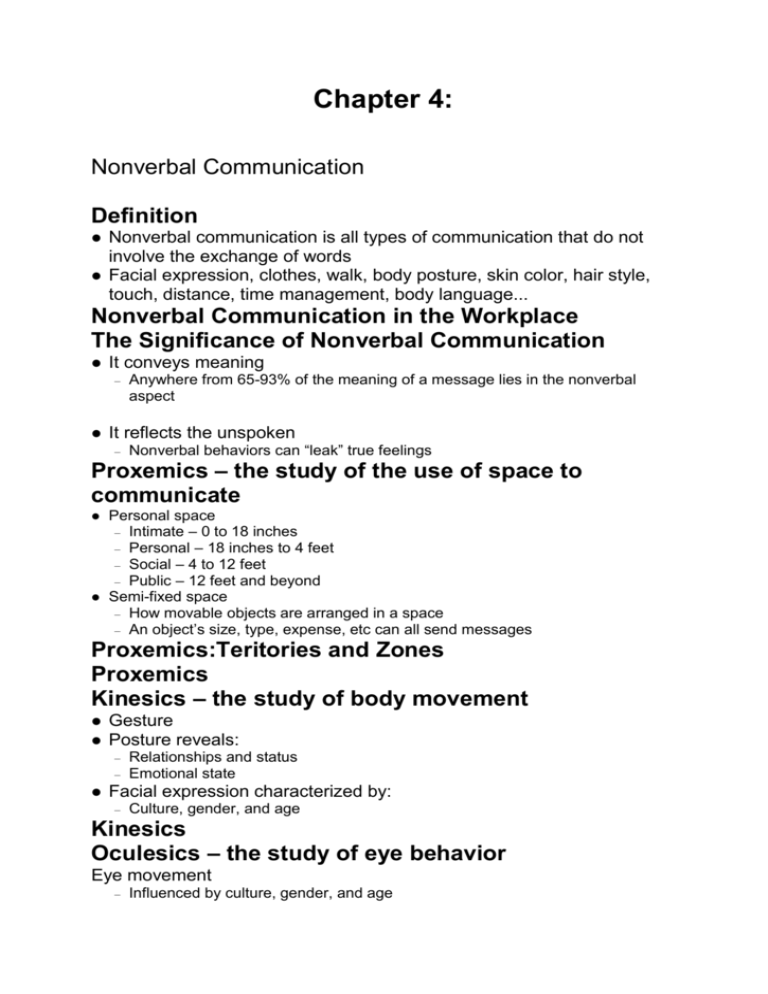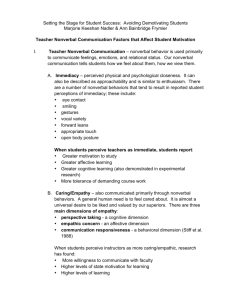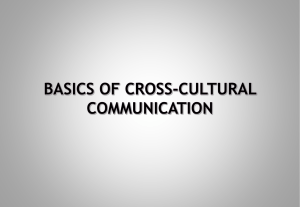Chapter 4 - Business Information Management
advertisement

Chapter 4: Nonverbal Communication Definition Nonverbal communication is all types of communication that do not involve the exchange of words Facial expression, clothes, walk, body posture, skin color, hair style, touch, distance, time management, body language... Nonverbal Communication in the Workplace The Significance of Nonverbal Communication It conveys meaning – Anywhere from 65-93% of the meaning of a message lies in the nonverbal aspect It reflects the unspoken – Nonverbal behaviors can “leak” true feelings Proxemics – the study of the use of space to communicate Personal space – Intimate – 0 to 18 inches – Personal – 18 inches to 4 feet – Social – 4 to 12 feet – Public – 12 feet and beyond Semi-fixed space – How movable objects are arranged in a space – An object’s size, type, expense, etc can all send messages Proxemics:Teritories and Zones Proxemics Kinesics – the study of body movement Gesture Posture reveals: – – Relationships and status Emotional state Facial expression characterized by: – Culture, gender, and age Kinesics Oculesics – the study of eye behavior Eye movement – Influenced by culture, gender, and age – – – – – Conveys interest Regulates conversation Establishes credibility Americans typically prefer “soft” eye contact Asian cultures typically prefer very little eye contact Haptics – the study of touch as used to communicate What are the touch norms at our university? How do you express emotions through touch? – Hug, pat on the back, slap on the face How is touch used in a business and professional context? Vocalics – the study of the use of the voice to convey meaning Regulates conversation – – Vocal cues Turn taking Helps interpret oral communication – – – Volume Pitch Rate Chronemics – the study of time usage in communication How we regulate interactions How we treat others – “wait time” How we prioritize Objectics – the study of how objects influence communication Nonverbal Communication in the Workplace Remember: Actions sell louder than words! Nonverbal Communication in Business Important nonverbal behaviors in business context: – Shaking hands – Eye contact and smiling – Removing desks and tables as barriers – Using the voice effectively – Matching time orientations – Nodding your head – Avoiding nervous gestures – Stop talking and listen – Pacing toward “low and slow” Guidelines for Effective Nonverbal Communication You cannot read people “like a book” Consider your nonverbal messages Recognize the impact status and power have Observe nonverbal messages in clusters Be cautious when generalizing the meaning of nonverbal cues Language and Technology Receivers can’t observe important elements – Tone of voice – Facial expression – Body posture New language has emerged with email, IMs








